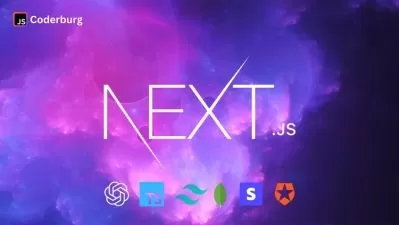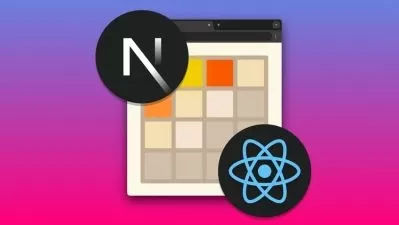Next JS Authentication System ,Learn Next JS 13 From Scratch
K.Sathyaprakash Reddy
5:51:11
Description
Learn Next JS v13 by Building a FullStack Authentication Project From Scratch
What You'll Learn?
- React vs Next
- Comparing Next JS 13 with Previous Versions
- Server Components and Client Components
- Disadvantages of server components and how to overcome those by using child client components
- Full stack Authentication System From Scratch
- Handling JWT Tokens , Sessions , Cookies , Headers etc.
- Working with email verification functionality and password reset functionality
- Protected Pages and API routes with middlewares
Who is this for?
What You Need to Know?
More details
DescriptionHello , Welcome to the course Next JS Authentication System ,Learn Next JS 13 From Scratch
In this comprehensive course on building authentication systems with Next.js 13, you will learn everything you need to develop secure and scalable authentication for your Next applications.
We will start by covering the fundamentals of Next.js, comparing Next.js 13 features to Next.js 12 and React, explaining key concepts like routing, rendering and API routes.
The course then dives into advanced Next.js topics like handling HTTP headers, cookies, and local storage - essential knowledge for authentication.
Next, we will build a full authentication system with features like:
• User login and registration forms
• Checking for duplicate users during registration
• Securing routes with JWT tokens
• Implementing email verification
• Password reset functionality
• Middleware for protected routes
You will learn how to manage user sessions, issue and verify JWT tokens, and restrict access to certain pages and APIs based on authentication. We will use industry best practices and discuss trade-offs of different approaches.
By the end of the course, you'll have a strong foundation in Next.js and the skills to build robust authentication systems for your own Next applications from scratch. You'll be able to securely manage user accounts and tokens, and restrict access to sensitive data and functionality.
Next.js 13 is the latest version of the popular React framework. It was released on March 8, 2023, and includes a number of new features and improvements.
Here are some of the highlights of Next.js 13:
New Image component: The new Image component makes it easier to display images without layout shift and optimize files on-demand for increased performance.
New Font system: The new Font system automatically optimizes your fonts, including custom fonts. It also removes external network requests for improved privacy and performance.
New App Router: The new App Router provides a more flexible and powerful way to manage routing in your Next.js application.
Improved performance: Next.js 13 includes a number of performance improvements, including faster image loading and improved hydration.
If you're using Next.js, I recommend upgrading to version 13. It's a major release with a number of great new features and improvements.
Here are some additional details about the new features in Next.js 13:
New Image component: The new Image component is a major improvement over the previous Image component. It supports native lazy loading, which means that images are only loaded when they are visible on the screen. This can significantly improve performance, especially on mobile devices. The new Image component also supports automatic image optimization, which can further improve performance.
New Font system: The new Font system is a major improvement over the previous font system. It automatically optimizes your fonts, including custom fonts. It also removes external network requests for improved privacy and performance. The new Font system also supports automatic self-hosting for any font file. This means that you can host your fonts on your own server, which can further improve performance.
New App Router: The new App Router is a major improvement over the previous router. It provides a more flexible and powerful way to manage routing in your Next.js application. The new App Router supports nested routes, dynamic routes, and more.
Improved performance: Next.js 13 includes a number of performance improvements, including faster image loading and improved hydration. Hydration is the process of converting a server-rendered page into a client-rendered page. Next.js 13 has improved hydration performance, which can lead to a smoother user experience.
If you're using Next.js, I recommend upgrading to version 13. It's a major release with a number of great new features and improvements.
Who this course is for:
- Students who want to learn full-stack applications with Next JS
- Students who want to perceive their carrier in web developent
- MERN Stack Developers
- Front End Developers
Hello , Welcome to the course Next JS Authentication System ,Learn Next JS 13 From Scratch
In this comprehensive course on building authentication systems with Next.js 13, you will learn everything you need to develop secure and scalable authentication for your Next applications.
We will start by covering the fundamentals of Next.js, comparing Next.js 13 features to Next.js 12 and React, explaining key concepts like routing, rendering and API routes.
The course then dives into advanced Next.js topics like handling HTTP headers, cookies, and local storage - essential knowledge for authentication.
Next, we will build a full authentication system with features like:
• User login and registration forms
• Checking for duplicate users during registration
• Securing routes with JWT tokens
• Implementing email verification
• Password reset functionality
• Middleware for protected routes
You will learn how to manage user sessions, issue and verify JWT tokens, and restrict access to certain pages and APIs based on authentication. We will use industry best practices and discuss trade-offs of different approaches.
By the end of the course, you'll have a strong foundation in Next.js and the skills to build robust authentication systems for your own Next applications from scratch. You'll be able to securely manage user accounts and tokens, and restrict access to sensitive data and functionality.
Next.js 13 is the latest version of the popular React framework. It was released on March 8, 2023, and includes a number of new features and improvements.
Here are some of the highlights of Next.js 13:
New Image component: The new Image component makes it easier to display images without layout shift and optimize files on-demand for increased performance.
New Font system: The new Font system automatically optimizes your fonts, including custom fonts. It also removes external network requests for improved privacy and performance.
New App Router: The new App Router provides a more flexible and powerful way to manage routing in your Next.js application.
Improved performance: Next.js 13 includes a number of performance improvements, including faster image loading and improved hydration.
If you're using Next.js, I recommend upgrading to version 13. It's a major release with a number of great new features and improvements.
Here are some additional details about the new features in Next.js 13:
New Image component: The new Image component is a major improvement over the previous Image component. It supports native lazy loading, which means that images are only loaded when they are visible on the screen. This can significantly improve performance, especially on mobile devices. The new Image component also supports automatic image optimization, which can further improve performance.
New Font system: The new Font system is a major improvement over the previous font system. It automatically optimizes your fonts, including custom fonts. It also removes external network requests for improved privacy and performance. The new Font system also supports automatic self-hosting for any font file. This means that you can host your fonts on your own server, which can further improve performance.
New App Router: The new App Router is a major improvement over the previous router. It provides a more flexible and powerful way to manage routing in your Next.js application. The new App Router supports nested routes, dynamic routes, and more.
Improved performance: Next.js 13 includes a number of performance improvements, including faster image loading and improved hydration. Hydration is the process of converting a server-rendered page into a client-rendered page. Next.js 13 has improved hydration performance, which can lead to a smoother user experience.
If you're using Next.js, I recommend upgrading to version 13. It's a major release with a number of great new features and improvements.
Who this course is for:
- Students who want to learn full-stack applications with Next JS
- Students who want to perceive their carrier in web developent
- MERN Stack Developers
- Front End Developers
User Reviews
Rating
K.Sathyaprakash Reddy
Instructor's Courses
Udemy
View courses Udemy- language english
- Training sessions 33
- duration 5:51:11
- English subtitles has
- Release Date 2023/07/04






![Build a Travel Blog App with React and Chakra UI MERN [2023]](https://traininghub.ir/image/course_pic/8768-x225.webp)









